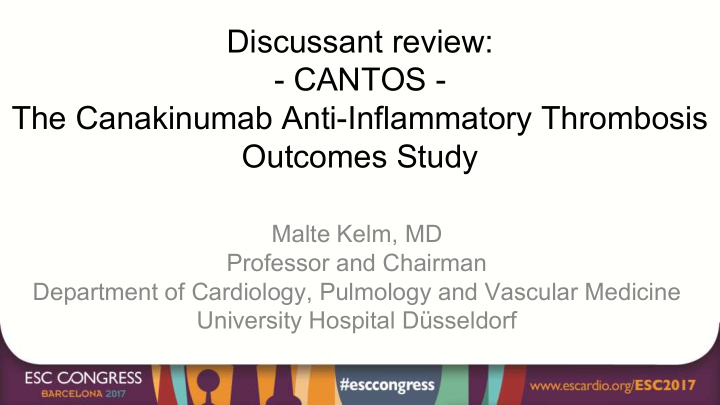



Discussant review: - CANTOS - The Canakinumab Anti-Inflammatory Thrombosis Outcomes Study Malte Kelm, MD Professor and Chairman Department of Cardiology, Pulmology and Vascular Medicine University Hospital Düsseldorf
CANTOS: C anakinumab An ti-Inflammatory T hrombosis O utcomes S tudy • Chronic inflammation in atherosclerosis • Patient (and target) population • Effect size, tailoring therapy • Non-cardiovascular effects and safety
hsCRP reflects inflammation in humans effect size stability N Engl J Med 1997;336:973-979
hsCRP reflects inflammation in humans effect size independent risk indication IL6 upstream signalling stability N Engl J Med 1997;336:973-979 Lancet. 2010;375:132-140 Eur Heart J. 2014;35:578-89
Activation of inflammasome - “clinical utility” NLRP3 & Ischemia inflammasome target IL-1β converter TNF Canakinumab distributor IL-6 hsCRP biomarker Circ Res. 2016;118:145-156
Cholesterol crystals induce local and systemic inflammation experimental studies monocytes & macrophages volume expansion intima perforation
Cholesterol crystals induce local and systemic inflammation experimental studies monocytes & macrophages volume expansion intima perforation human studies Carotid artery coronary artery systemic effects Science. 2015;349:237-8, Eur Heart J. 2016;37:1959-67, Circ. Res. 2017;120:1947-57
Residual risk in HR-patients with CAD: >50% Known Cardiovascular Disease LDL 150 mg/dL hsCRP 4.5mg/L High Intensity Statin “Residual Cholesterol Risk” “Residual Inflammatory Risk” LDL 110 mg/dL LDL 80 mg/dL hsCRP 1.8 mg/L hsCRP 3.8 mg/L Additional Additional LDL Reduction Inflammation Reduction IMPROVE-IT : Ezetimibe 6% RRR CANTOS: Proof of Concept FOURIER/SPIRE: PCSK9 Inhibition q2 weeks 15% RRR Eur Heart J 2016;37:1720-22
PROSPECT - event rate post pPCI / AMI CANTOS - baseline clinical characteristics N Engl J Med 2011;364:226-35 Ridker ESC 2017
Ridker ESC 2017
Tailored therapy in CAD Known Cardiovascular Disease LDL 150 mg/dL hsCRP 4.5mg/L High Intensity Statin “Residual Cholesterol Risk” “Residual Thrombotic Risk” “Residual Inflammatory Risk” LDL high LDL low HTPR hsCRP low hsCRP high ? Additional Additional Additional antiplatelet & LDL Reduction Inflammation Reduction anticoagulant therapy
IL-1β in sterile inflammation and non-CVD Canakinumab Nat Rev Drug Discov; 2012,11: 633-652
CRP & (non) cardiovascular mortality Lancet 2010; 375: 132-40
Ridker ESC 2017
CANTOS : C anakinumab An ti-Inflammatory T hrombosis O utcomes S tudy • supports the concept of causal anti-inflammatory therapy in atherosclerosis • offers the perspective of tailored indication, treatment & monitoring of anti-inflammatory therapy in secondary prevention in high risk patients • need to proof the transition of this concept to patients with AMI • safety has to be further evaluated in post-trial registries in cardiology and oncology, as with other anti-inflammatory agents tested in ongoing trials
Recommend
More recommend